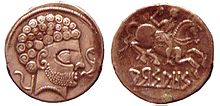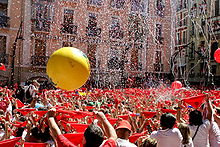Navarre: Difference between revisions
No edit summary |
→Cultural heritage: Section rearranged |
||
| Line 96: | Line 96: | ||
==Cultural heritage== |
==Cultural heritage== |
||
[[Image:Leire.jpg|right|thumb|180px|[[Monastery of Leyre]]]] |
[[Image:Leire.jpg|right|thumb|180px|[[Monastery of Leyre]]]] |
||
Navarre is a mixture of its ancient tradition and [[Mediterranean]] influences coming from the [[Ebro]]. The [[Ebro]] valley is amenable to [[wheat]], [[vegetable]]s, [[wine]], and even [[olive tree]]s as in [[Aragon]] and [[La Rioja (Spain)|La Rioja]]. It was a part of the [[Roman Empire]], |
Navarre is a mixture of its [[Basque people|Vasconic]] ancient tradition and [[Mediterranean]] influences coming from the [[Ebro]]. The [[Ebro]] valley is amenable to [[wheat]], [[vegetable]]s, [[wine]], and even [[olive tree]]s as in [[Aragon]] and [[La Rioja (Spain)|La Rioja]]. It was a part of the [[Roman Empire]], inhabited by the [[Vascones]], later controlled on its southern fringes by the [[Banu Qasi]], whose authority was taken over by the [[taifa]] kingdom of [[Tudela]] in the 11th century. |
||
During the [[Reconquista]], Navarre gained little ground at the expense of the Muslims. Starting in the 11th century, the [[Way of Saint James]] grew a very important milestone for the territory and source of European cultural influence. [[Gascony|Gascon]]s and [[Occitania]]ns altogether from beyond the [[Pyrenees]] (called ''Franks'') were granted privileges to foster their settlement in Navarrese towns, causing them to bring along their craft, culture and [[Romance languages|Romance]] languages. |
|||
Jews and Muslims couldn't escape the drastic measures imposed on them and were expelled for the most part in a process spanning half a century at the end of the 15th century and start of the 16th, definitely after Navarre was seized by Castile-Aragon. |
|||
==Energy policy== |
==Energy policy== |
||
Revision as of 16:21, 12 January 2010
Chartered Community of Navarre Comunidad Foral de Navarra Nafarroako Foru Erkidegoa | |
|---|---|
 Map of Navarra | |
| Country | |
| Capital | Pamplona |
| Government | |
| • President | Miguel Sanz (UPN) |
| Area (2.2% of Spain; Ranked 11th) | |
• Total | 10,391 km2 (4,012 sq mi) |
| Population (2007) | |
• Total | 620,337 |
| • Density | 60/km2 (150/sq mi) |
| • Pop. rank | 15th |
| • Percent | 1.3% of Spain |
| Demonym | |
| ISO 3166-2 | NA |
| Official languages | Spanish and Basque |
| Statute of Autonomy | August 16, 1982 |
| Parliament | Cortes Generales |
| Congress seats | 5 |
| Senate seats | 5 (4 elected and 1 appointed) |
| Website | Gobierno de Navarra |
Navarre (Template:Lang-es, Template:Lang-eu) is a region in northern Spain, constituting one of its autonomous communities - the "Chartered Community of Navarre" (Template:Lang-es; Template:Lang-eu).
History

During the time of the Roman Empire, the territory of the province was inhabited by the Vascones, a pre-Roman tribe who populated the southern slopes of the Pyrenees. The Vascones managed to maintain their separate Basque language and traditions even under the Roman rule.

The area was never fully subjugated either by the Visigoths or by the Arabs. In A.D. 778, the Basques defeated a Frankish army in the Battle of Roncevaux Pass. Two generations later, in 824, the chieftain Iñigo Arista was chosen King of Pamplona, laying a foundation for the later Kingdom of Navarre. That kingdom reached its zenith during the reign of Sancho III of Navarre and covered the area of the present-day Navarre, Basque country, and La Rioja, together with parts of modern Cantabria, Castile and León, and Aragon.
After Sancho III died, the Kingdom of Navarre was divided between his sons and never fully recovered its importance. The army of Navarre fought beside other Christian Spanish kingdoms in the decisive battle of Las Navas de Tolosa in 1212, after which the Muslim conquests on the Iberian Peninsula were slowly reduced to a small territory in the south.
In A.D. 1515, the bulk of Navarre below the Pyrenees—Upper Navarre—was at last absorbed into a re-united Kingdom of the Spains but retained some rights specific to it. The small portion of Navarre lying north of the Pyrenees—Lower Navarre—later came under French rule when its Huguenot sovereign became King Henri IV of France; with the declaration of the French Republic and execution of Louis XVI, the last King of France and Navarre, the kingdom was merged into a unitary French state.
Community, geography, and climate

The community is governed as an autonomous region with its own parliament (Parlamento de Navarra) and government (Gobierno de Navarra). As in other autonomous regions in Spain, health, employment, education, and social services, together with housing, urban development, and environment protection policies are under the responsibility of its own institutions. Unlike other regions (and like the Basque Country), it has almost full responsibility for collecting and administering taxes which must follow the overall guidelines established by the Spanish government but may have some minor differences.
It is made up of 272 municipalities and has a total population of 601,874 (2006), of which approximately one-third live in the capital, Pamplona (195,769 pop.), and one-half in the capital’s metropolitan area (315,988 pop.). There are no other large municipalities in the region. The next largest are Tudela (32,802), Barañáin (22,401), Burlada (18,388), Estella - Lizarra (13,892), Zizur Mayor (13,197), Tafalla (11,040), Villava/Atarrabia (10,295), and Ansoáin (9,952).
Despite its relatively small size, Navarre features stark contrasts in geography, from the Pyrenees mountain range that dominates the territory to the plains of the Ebro river valley in the south. The highest point in Navarre is Hiru Erregeen Mahaia, with an elevation of 2,428 metres (7,965 feet).
Climate
The climate of Navarre mixes influences from the Pyrenees mountains and Ebro river valley, creating a great difference between the climates of the north (much more humid and with frequent rainfall) and of the south (more Mediterranean with higher temperatures and more sporadic precipitation). One can pass from the humid Cantabrian valleys in the north to the arid, steppe-like Bardenas Reales on the banks of the Ebro river in just a few kilometers
Cultural heritage

Navarre is a mixture of its Vasconic ancient tradition and Mediterranean influences coming from the Ebro. The Ebro valley is amenable to wheat, vegetables, wine, and even olive trees as in Aragon and La Rioja. It was a part of the Roman Empire, inhabited by the Vascones, later controlled on its southern fringes by the Banu Qasi, whose authority was taken over by the taifa kingdom of Tudela in the 11th century.
During the Reconquista, Navarre gained little ground at the expense of the Muslims. Starting in the 11th century, the Way of Saint James grew a very important milestone for the territory and source of European cultural influence. Gascons and Occitanians altogether from beyond the Pyrenees (called Franks) were granted privileges to foster their settlement in Navarrese towns, causing them to bring along their craft, culture and Romance languages.
Jews and Muslims couldn't escape the drastic measures imposed on them and were expelled for the most part in a process spanning half a century at the end of the 15th century and start of the 16th, definitely after Navarre was seized by Castile-Aragon.
Energy policy
Navarre leads Europe in its use of renewable energy technology and is planning to reach 100% renewable electricity generation by 2010. By 2004, 61% of the region's electricity was generated by renewable sources consisting of 43.6% from 28 wind farms, 12% from over 100 small-scale water turbines, and 5.3% from 2 biomass and 2 biogas plants. In addition, the region had what was then Spain's largest photovoltaic power plant at Montes de Cierzo de Tudela (1.2 MWp capacity) plus several hundred smaller photovoltaic installations.
Developments since 2004 have included further photovoltaic plants at Larrión (0.25 MWp)[1] and another at Castejón (2.44 MWp), also once the largest in Spain.[2]
Languages

Spanish is the official language in Navarre, together with Basque that is also an official language but only in the Basque speaking area.[3] The north-western part of the community is largely Basque-speaking, while the southern part except Fitero is almost completely Spanish-speaking. The capital Pamplona is in the mixed region. Navarre is divided into three parts linguistically: regions where Basque is widespread (the Basque-speaking area), regions where Basque is present (the mixed region), and regions where Basque is absent (the Spanish-speaking area).[4]
See also
- Basque language
- Euskadi
- Kingdom of Navarre
- Kings of Navarre
- Lower Navarre
- Parliament of Navarre
- Renewable energy in the European Union
References

- ^ Iberinco to Construct Solar Installation at Renewable Facility | Renewable Energy Today | Find Articles at BNET
- ^ http://www.energias-renovables.com/english/Contenidosecciones.asp?ID=7584&Tipo=&Nombre=News
- ^ http://www.parlamento-navarra.es/castellano/pdfs/amejoramiento.pdf
- ^ O. Leg. I - Ley Foral 18/1986 de 15-12-1986
External links
- Official website (in Basque/English/French/Spanish)
- History of Navarre
- (LAS BARDENAS, CAVERN, GROTTE VALTIERRA, CUEVAS DE VALTIERRA)
- Bardenas Reales desert (Navarra)
- Northern Spanish region leads way on renewable energy
- Template:PDFlink
- Euskara Kultur Elkargoa-Basque Cultural Foundation
- Navarra en Fotos
- Saint James route and wine


